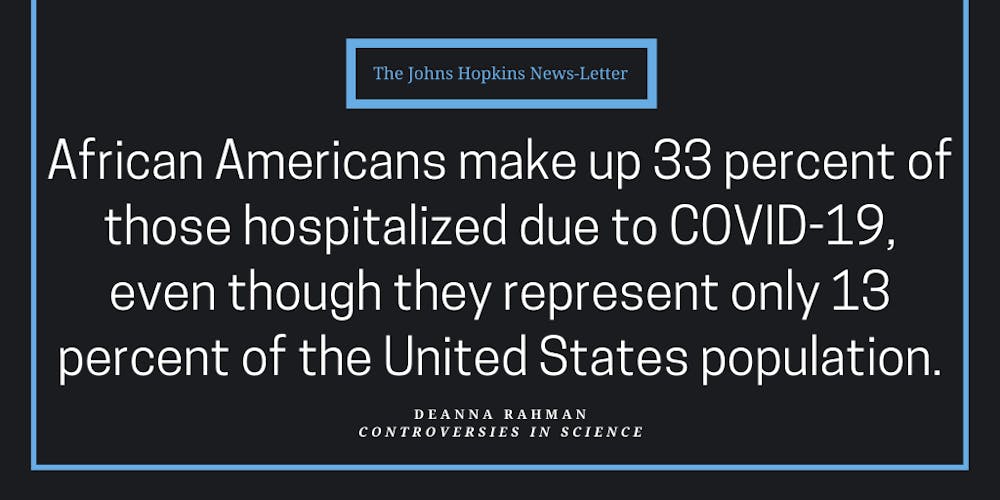
As an individual afforded the luxury of staying home, the ever present screen in front of me oscillates between the news, the Netflix show I’ve chosen to binge-watch and the assignment I’m avoiding. My obsessive review of coronavirus (COVID-19) updates usually leads to one of two outcomes: If I’m feeling hopeful, the assignment suddenly doesn’t seem so bad, especially with an encouraging friend on FaceTime. If I’m feeling disheartened, another episode of Tiger King it is.
Nothing about this pattern of behavior seemed particularly worrisome to me — I imagined those who are also at home had fallen into a similar routine. Then, headlines detailing how COVID-19 is disproportionately affecting African Americans started to fill my newsfeed. These headlines did not lead to another episode of Tiger King. Instead, they led to the abrupt yet necessary realization that over the last few weeks, my privilege had transformed into complacency. I decided to break out of the state I had been lulled into, and write.
According to the Centers for Disease Control and Prevention (CDC), African Americans make up 33 percent of those hospitalized due to COVID-19, even though they represent only 13 percent of the United States population. Even more alarming, according to data collected by the American Community Survey (ACS), African Americans accounted for more than 40 percent of COVID-19 fatalities in the U.S., where the race of victims was made publicly known.
The following data from Hopkins, state health departments and the ACS further emphasizes this disproportionate pattern:
- Milwaukee County, Wis.: African Americans are 26 percent of the population, but 56 percent of deaths
- Louisiana: African Americans are 32 percent of the population, but 59 percent of deaths
- Illinois: African Americans are 15 percent of the population, but 40 percent of deaths
- Michigan: African Americans are 14 percent of the population, but 40 percent of deaths
The disproportionate effect the COVID-19 pandemic has had on African American communities brings forward longstanding, unresolved issues related to structural racism within the U.S. African Americans are disproportionately affected by COVID-19 for a number of factors. African Americans are more likely to have health conditions like hypertension, diabetes, asthma and heart disease, all of which has been linked to the systemic issues of housing inequality and increased poverty rates.
Substandard housing conditions contribute to the development of underlying health conditions that make African Americans more likely to die from COVID-19. For example, Princeton University’s 2017 study suggested that persistent residential segregation trapped minority children in unhealthy, polluted neighborhoods, resulting in childhood asthma. Data from the U.S. Bureau of Labor Statistics shows that African Americans are overrepresented in professions where there is an increased level of contact with others, such as the food service, as well as hotel and taxi industries. This means that a disproportionately high number of African Americans are essential workers, and therefore at higher risk of being exposed to COVID-19.
Many African Americans still lack access to adequate health care. According to the CDC, while African Americans are more likely to die at an early age from any cause than white Americans, 19 percent of African Americans cannot afford to see a doctor. Additionally, 11.5 percent of African Americans are uninsured, which could discourage some from seeking treatment.
Moreover, some members of the African American community do not receive the care they need due to the racial empathy gap in health care. This unacceptable gap can be seen in the handling of COVID-19; COVID-19 testing sites are more often than not located in high-income, historically white areas even though the rate of infection of African Americans is twice that of caucasians.
While reading countless articles and watching various news segments on COVID-19 and its disproportionate effect on African Americans, I couldn’t help but notice the repeated use of words like “usual” when describing disparities and “longstanding” or “familiar” when describing patterns of racial and economic bias. The saying “When America catches a cold, black people get the flu” is becoming an increasingly popular lede, and it is clear that too many of us have allowed our privilege to turn into complacency.
I urge you to realize that change is both possible and necessary — racial and socioeconomic health disparities are simply unacceptable. It is disappointing that a global pandemic as devastating as COVID-19 was needed to elevate the collective awareness of the negative impacts caused by our country’s racial and income fault lines. I only hope that we are able to keep this awareness in mind and use it as a driving force for change once we’ve flattened the curve.





